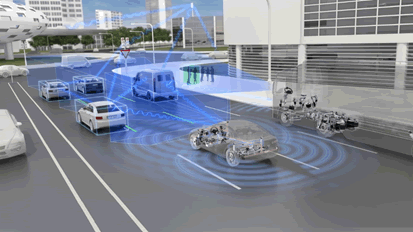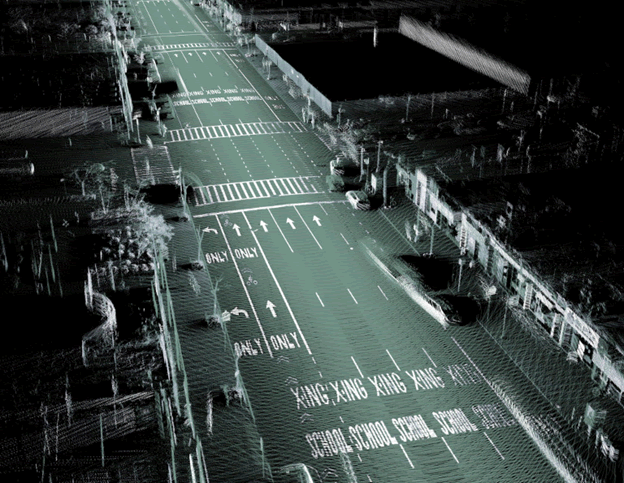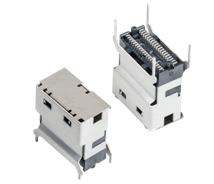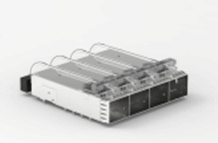Cars Drive Growth for Data Center Connectors
Connectivity and autonomy in next-generation autos is creating lots of data that will be sent to data centers, fostering a new market for connector makers.
The explosion of electronics in vehicles continues to drive solid growth in the market for connectors. Typically, we think of these as harsh-environment connectors that can meet the rigorous demands of rough roads in environments ranging from steamy Florida to frigid Finland. But emerging automotive trends are creating opportunities for other types of connectors in a distinctly non-automotive area: data centers.

Autonomous cars generate terabytes of data every hour, sending much of it to the cloud. (Source: ZF)
Connectivity and autonomy are the leading factors altering the auto industry’s scope of operations. Connected vehicles, which are rapidly becoming the norm in advanced countries, let OEMs and insurers download the copious amount of data generated throughout the vehicle. Carmakers can use this data to run diagnostics and monitor the usage and quality of electronic systems, and insurers can use it to tap into vehicle networks to learn about mileage, speed, braking, and other parameters that help them determine rates.
In the longer term, the emergence of autonomous vehicles exacerbates the data flow from vehicles. Driverless cars will generate terabytes of data every hour. This data will flow to the cloud, where germane bits of information will be processed to help cars drive efficiently and safely.
This big data challenge represents a marked change for automakers, who typically haven’t done much with vehicles after they’re shipped to dealers, as they’ll now have continuous involvement with vehicles via a constant flow of incoming data.
The demands for intense automotive data handling are impacting the connector market, creating an even greater demand for components that handle high volumes of high-bandwidth data in data centers and cloud computing facilities, and are a far cry from the ruggedized connectors typically associated with the auto industry.
Companies large and small are jockeying for position to handle the myriad segments of data these vehicles generate. Insurance companies are establishing partnerships that will help them collect data for usage-based insurance.
Octo Telematics, which provides global data handling services for insurers, is investing $40 million to update a platform that is already being used on over five million vehicles. Data services giant LexisNexis made several presentations at the recent Connected Car Insurance conference, highlighting its interest in handling some of the information streaming from vehicles. EMC Insurance Co. has partnered with both LexisNexis and Octo Telematics, and Mitsubishi Automotive has also teamed up with LexisNexis.

Octo Telematics is helping insurers collect data from cars, paving the road for driverless vehicles.
Connectivity makes cloud computing a natural extension for automotive features and functions. Navigation systems and notoriously unreliable on-vehicle voice recognition are among the applications that can benefit from the computing capabilities of remote servers. Enhanced mapping services go hand-in-hand with cloud-based navigation. Many development teams are working to provide extremely high-resolution maps, which can help keep vehicles precisely in the center of lanes that have minute curves. Real-time maps that adjust routes during construction projects and let cars avoid potholes are also possible when cars constantly feed data to the cloud.
Cloud services providers are beginning to focus on this emerging market. Some are planning to shift from a few huge data centers to establishing a number of smaller facilities scattered around the country. Putting data centers closer to the cars they service will reduce latency times, which are a critical factor for any applications related to the safety or piloting of a vehicle.
There’s keen interest in the field. Google and Apple both continuously upgrade their mapping programs, while TomTom and Garmin continue to enhance their mapping and navigation technologies to meet autonomous vehicle requirements. HERE, a digital mapping company that was formerly known as Navteq and was later acquired by Nokia, has several auto-industry partnerships. Startups like Carmera, Civil Maps, Lvl5, and DeepMap are racing to get in on the ground floor of what’s expected to be a huge market as well.

High-resolution maps from HERE will help cars stay in their lanes.
Automakers also plan to collect data from their cars. This information can be analyzed to see how users interact with various controls, features, and functions, and to help OEMs learn how to predict failures. When software problems are found, carmakers can send out automatic firmware updates.
Autonomous driving will add huge volumes of information that will be sent to the cloud. Remote processing can be used for a number of tasks that don’t require immediate response. A continuous stream of data will be used to feed artificial intelligence programs that will improve systems. Vehicle-to-vehicle infrastructure communications will tell vehicles about black ice, hidden vehicles, and other information that can be used to augment on-vehicle cameras, radar, and LIDAR.
In all these environments, reliability and speed will be paramount. When moving vehicles rely on remote data processing to make driving decisions, there’s no room for failure. Connectors used in these data centers will have to continue to evolve to meet the next need: handling petabytes of data in ever-shorter timeframes.
Data Center Connectors
Several leading connector suppliers are continually developing new interconnect solutions designed to meet today’s ever-increasing data center demands for high-speed connectivity.

Samtec’s Q Strip® interconnects
Samtec’s Q Strip® interconnects are designed for high-speed board-to-board applications that demand high signal integrity, including servers, networks, and test and measurement. Featuring surface mount signal contacts and a surface mount ground plane between the two rows of signals that can either be used to maximize bandwidth and signal integrity or as a power plane, the series is rated for 28Gb/s at a 5mm stack height and can be routed in single-ended or differential pair configurations. The series is available in vertical, right angle, and coplanar designs with up to 180 total I/Os, and mated sets are available in seven stack heights spanning 5–25mm.

Amphenol High Speed Interconnects’ UltraPort SlimSAS™ connector series
Amphenol High Speed Interconnects’ UltraPort SlimSAS™ connector series is designed to address various interconnect issues in next-generation storage device applications, including: servers, switches, routers, and data centers. The proven high-speed connector series delivers 0.6mm-pitch, 22.5Gb/s-per-lane, vertical and right-angle solutions that consume the same area as the MiniSAS HD 4x, feature a friendly ribbon cable design that supports both blade and mainstream servers, and are adopted for next-generation SAS-4.

TE Connectivity’s microQSFP pluggable I/O interconnects
TE Connectivity’s microQSFP pluggable I/O interconnects deliver 56Gb/s performance with backward compatibility to 28Gb/s to support next-generation designs and solve bandwidth, thermal performance, and energy cost challenges in data storage center applications The series delivers QSFP28 functionality in a smaller, generally SFP-sized form factor that provides 33% higher density than QSFP, as well as significantly improved thermal and electrical performance. It also features built-in fins that eliminate the need for additional clips and heatsinks and allow faceplate airflow to the equipment’s interior.
These and other top connector suppliers are sure to provide critical enabling support for satisfying the new high-speed data processing demands of ever-larger fleets of increasingly interconnected vehicles.
Recently posted:
[related_posts limit=”10″]
- State of the Industry: 2022-2023 Connector Sales - April 16, 2024
- Amphenol is On a Roll - April 2, 2024
- Nicomatic Proves That Two Heads are Better Than One - March 26, 2024






